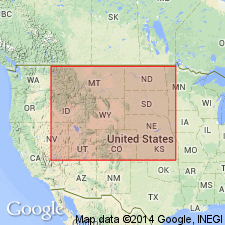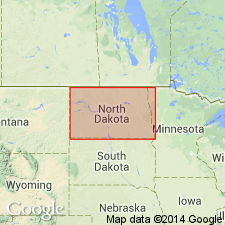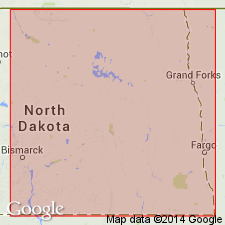
- Usage in publication:
-
- Tilston beds
- Modifications:
-
- Named
- Dominant lithology:
-
- Anhydrite
- AAPG geologic province:
-
- Williston basin
Summary:
A subdivision of Madison Group in northeastern part of Williston basin in ND, Saskatchewan and Manitoba, based on correlation of widespread mechanical-log marker horizons. Named for Tilston oil field in Manitoba. A complete section lies between 3,470 ft and 3,622 ft in Souris Valley Oil Co., Gordon White no. 1 well, Lsd. 5, sec 14, T1, R28, West 1st Meridian, Manitoba. Lower boundary is top of Souris Valley beds (new); upper boundary the top of a thin but widespread argillaceous bed, which, in the eastern part of the region, overlies an evaporitic anhydrite. This anhydrite, together with the overlying argillaceous bed, was defined by Thomas [G. E., 1954, The Mississippian of the northeastern Williston basin: Transactions Canadian Institute Mining and Metallurgy, v. 57, p. 68-74] as the M.C. 2 member of the Mission Canyon Formation, while underlying limestones above Souris Valley beds comprised his M.C. 1 member. Overlain by Frobisher-Alida beds (new). Correlation shown in four cross sections in Saskatchewan, Manitoba, MT, and ND. Mississippian in age.
Source: GNU records (USGS DDS-6; Denver GNULEX).

- Usage in publication:
-
- Tilston interval
- Modifications:
-
- Overview
- AAPG geologic province:
-
- Williston basin
Summary:
Tilston interval (informal) of Madison group. Defined by mechanical-log markers; boundaries are same as those defined by Saskatchewan Geological Society (1956). Present in subsurface of the Williston basin, North Dakota. Thickness averages about 150 feet. Overlain by Frobisher-Alida interval (informal) of Madison group; underlying interval not discussed. Age is Mississippian. Electric-log characteristics shown for the Carter-Phillips G. Blower No. 1 well, in SE/4 SW/4 sec. 20, T. 160 N., R. 83 W., Bottineau Co., ND, and on a detailed electric- and radioactivity-log correlation diagram extending from Renville Co., ND, southward to Sioux Co., ND.
Source: Modified from GNU records (USGS DDS-6; Denver GNULEX).

- Usage in publication:
-
- Tilston interval
- Modifications:
-
- Overview
- AAPG geologic province:
-
- Williston basin
Summary:
Tilston interval (informal) of Madison Group. Defined by mechanical-log markers. Present in subsurface of the Williston basin, North Dakota. Compares usage of the term by some previous authors in North Dakota and southeastern Saskatchewan. Summarizes lithologic and stratigraphic relations. Thickness as much as 210 feet in central and eastern North Dakota. Age is Early Mississippian (late Kinderhookian to early Osagean), based on correlation with equivalent rocks in Manitoba. Electric-log characteristics shown for the Carter Oil Company, E.L. Semling No. 1 well, in sec. 18, T. 141 N., R. 81 W., Oliver Co., ND. Report also includes isopach map.
Source: Modified from GNU records (USGS DDS-6; Denver GNULEX).
For more information, please contact Nancy Stamm, Geologic Names Committee Secretary.
Asterisk (*) indicates published by U.S. Geological Survey authors.
"No current usage" (†) implies that a name has been abandoned or has fallen into disuse. Former usage and, if known, replacement name given in parentheses ( ).
Slash (/) indicates name conflicts with nomenclatural guidelines (CSN, 1933; ACSN, 1961, 1970; NACSN, 1983, 2005, 2021). May be explained within brackets ([ ]).

